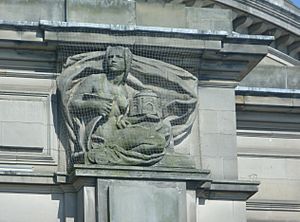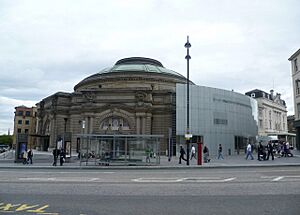Usher Hall facts for kids

The Usher Hall as seen from Lothian Road
|
|
| Address | Lothian Road Edinburgh EH1 2EA |
|---|---|
| Location | Edinburgh, Scotland |
| Coordinates | 55°56′48″N 3°12′15″W / 55.94675°N 3.20420°W |
| Owner | City of Edinburgh Council |
| Type | Concert hall |
| Capacity | 2,200 |
| Construction | |
| Opened | 16 March 1914 |
| Renovated | 2010 |
| Architect | Stockdale Harrison and Howard H Thomson |
The Usher Hall (Scottish Gaelic: Talla Usher) is a famous concert hall located in the West End area of Edinburgh, Scotland. The City of Edinburgh Council owns and manages this special building. It has been a popular place for concerts and events since it first opened its doors in 1914.
This amazing venue can hold about 2,200 people. Its main hall, called the auditorium, was recently made new again. Performers really love playing here because of its fantastic sound quality. The Usher Hall has hosted some big events. For example, the Eurovision Song Contest took place here in March 1972. This was the first time Scotland hosted this huge music competition! It also hosted Eurovision Young Musicians in August 2018. In 1986, when Edinburgh hosted the Commonwealth Games, the Usher Hall was used for the boxing matches.
The Usher Hall stands between two other important theatres: The Royal Lyceum Theatre to the south and The Traverse Theatre to the north. It is recognized as a very important building by Historic Environment Scotland, which means it has "Category A listed building" status.
Contents
The Hall's History
How the Usher Hall Was Built
The idea for the Usher Hall came from Andrew Usher. He was a successful whisky maker and blender. He gave £100,000 to the city specifically to build a new concert hall. This was a huge amount of money back then! Finding the right spot for the hall took some time. But in 1910, a competition was held for architects to design the building. The rule was that the hall should look simple but grand.
Out of 130 designs, the winning one came from Stockdale Harrison & Howard H Thomson. Their design was a bit different from the popular Victorian Gothic style of the time. It went back to classic looks, similar to the Beaux-Arts style. On July 19, 1911, King George V and Queen Mary visited to lay two special memorial stones. More than a thousand people came to watch this important event.
The Usher Hall has unique curved walls. These were possible because of new ways to use reinforced concrete at the time. The dome on top was designed to match the curves of the walls. It wasn't meant to create a domed ceiling inside, which could have made the sound bad.
Inside the hall, you can see beautiful plaster decorations. These were made by an Edinburgh artist named Harry Gamley. The figures in these decorations show famous people from the world of music and well-known Scots. Some of these include: Sir Walter Scott, Robert Burns, Allan Ramsay, R L Stevenson, Johann Sebastian Bach, George Frideric Handel, Wolfgang Amadeus Mozart, Johannes Brahms, Edvard Grieg and Anton Rubinstein. Harry Gamley also created two large figures on the outside of the building. These represent "Inspiration" and "Achievement." There are also three other figures by Crossland McClure, showing "the Soul of Music," "Music of the Sea," and "Music of the Woods."
Grand Opening of the Hall
The Usher Hall officially opened on March 16, 1914. The first concert featured music by famous composers like Handel, Bach, Wagner, Beethoven, and the Scottish composer Hamish MacCunn.
The total cost to build the Usher Hall was £134,000. Sadly, Andrew Usher, who donated the money, passed away before the building work even started.
The Hall's Social Life
The Usher Hall has been used for many different kinds of events over the years. Besides music, it has hosted political meetings, religious gatherings, charity fundraisers, and even sports. In 1914, Prime Minister H. H. Asquith gave a speech about the war, encouraging men to join up.
Sometimes, music and politics mixed. For example, there were concerts to raise money for a movement in Spain in the 1930s. Also, celebrations for Edinburgh's 600th birthday in 1929 took place here. Political rallies stopped being held at the Usher Hall after a big incident in 1934. A large protest happened outside, and some people were hurt.
In 1986, the Commonwealth Games came to Edinburgh. The Usher Hall was chosen to host the boxing tournament.
The Usher Hall has many rooms in its basement. This made it a good place to use as an air-raid shelter during the Second World War. Even though there are no records of it being used as a shelter, signs like "No Dogs" on internal doors show that they were ready for it.
Musical Moments at the Hall
The Usher Hall has been a stage for many famous classical musicians from around the world. The Vienna Philharmonic orchestra, led by Bruno Walter, played here at the very first Edinburgh Festival in 1947.
It is also the main home in Edinburgh for the Royal Scottish National Orchestra. They perform regularly during their concert season. Other groups like the Scottish Chamber Orchestra, Scottish Fiddle Orchestra, National Youth Orchestra of Scotland, and local choirs also perform here often.
As mentioned, the Eurovision Song Contest was held at the Hall in March 1972. It was presented by Moira Shearer. The Hall also hosted Eurovision Young Musicians in August 2018.
The Grand Organ
A very important part of the Usher Hall is its large organ. It was built in 1913 by Norman & Beard of Norwich and cost about £4000. The organ was designed to be the main focus of the Hall, both to look at and to listen to. The Usher Hall Organ Trust helps raise money to keep the organ in good condition.
For several years, the organ couldn't be played because it wasn't working well. This was due to problems with moisture and temperature control. The company Harrison and Harrison of Durham worked for three years to fix it. The organ was put back in place in 2002. It was played again in a special concert on June 7, 2003, by Gillian Weir.
The Usher Hall Today
Who Owns and Manages It?
The City of Edinburgh Council still owns and manages the Usher Hall. It is always busy with events. It's one of the main places for the Edinburgh International Festival. Other events like the Holocaust Memorial Ceremony and the Colin O'Riordan Memorial Concert have also been held here. Important "Freedom of the City" ceremonies have taken place at the hall. The most recent one was for the famous Scottish actor Sean Connery in 1991.
Making the Hall Better
On April 13, 1996, a large piece of plaster fell from the roof into the main hall. Luckily, only three chairs were damaged. But this showed that the Hall needed serious repairs. It needed to be made safe and protected from wind and water. The City of Edinburgh planned a big project to fix the hall and make it even better. This included making the auditorium suitable for different types of events and adding new places for food and tickets.
The project was supposed to cost £25 million and rely on money from the Lottery and Arts Council. However, the funding applications didn't work out, and the project stopped. In 1998, the City of Edinburgh announced it would put aside £9 million to start the repairs again.
In 2002, plans for a second phase of improvements were announced. This phase needed another £11 million. Work on this second part began in 2007. It added better facilities and public areas, including a new glass section. All the work was finished in 2010, costing a total of £40 million.
More to Explore
- List of Category A listed buildings in the Old Town, Edinburgh
- List of Edinburgh music venues
- List of concert halls
- Buildings next door:
- Royal Lyceum Theatre
- Traverse Theatre
See also
 In Spanish: Usher Hall para niños
In Spanish: Usher Hall para niños





